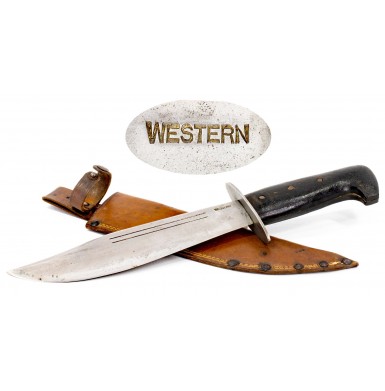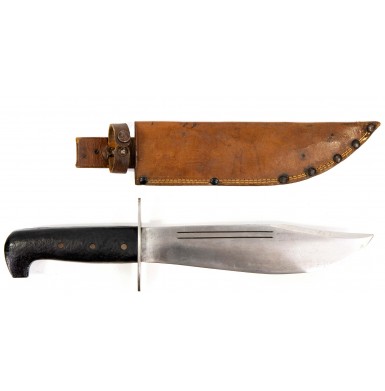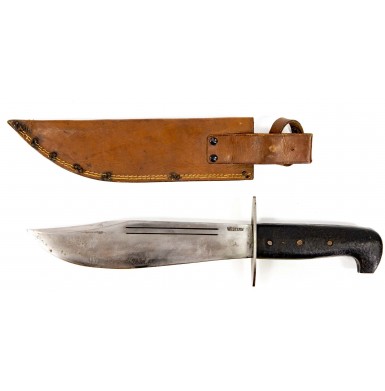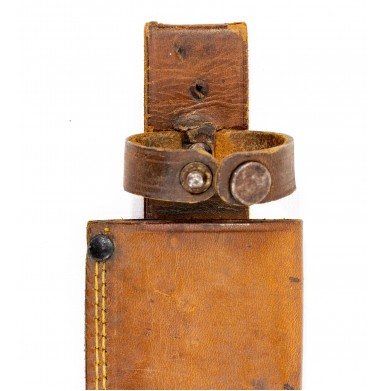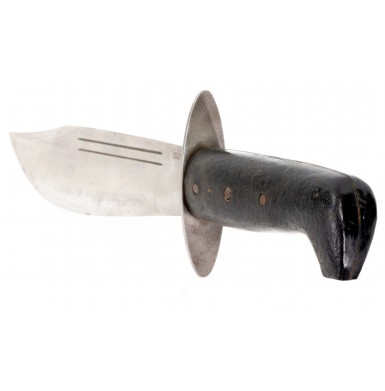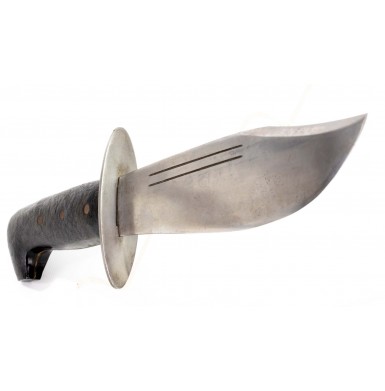Extremely Rare Western Cutlery V-44 Army Air Corps Survival Knife
- Product Code: EWSK-1627-SOLD
- Availability: Out Of Stock
-
$1.00
The very first US Army Air Corps survival knife was adopted in 1934 for use in the “bail out” kit of flyers stationed in tropical climates like Hawaii, Panama and the Pacific Islands. The original knife was the No 18 Machete, which was manufactured by Collins & Company. The original variant had an overall length of around 14 ¼”, +/- about ¼” with a clip point Bowie style blade that varied between about 9 ¼” to 9 ½” in length. The Collins made variant was initially produced with horn grip scales that were secured by brass rivets and had a brass cross guard with lobe shaped finials at the end that almost resembled a bar bell. During the production run of the Collins V-44, four variations were produced. The first two used the horn grip scales, initially secure by brass rivets as noted and the only difference between them was the type of blade stamping identifying the knife and the maker. The third and fourth versions replaced the horn grip with Bakelite, initially secured with brass rivets and with the final variant secured with steel rivets.
The survival machete has been known by collectors as the V-44 Survival Knife for many years, but most current researchers feel the name is inaccurate and is not a period term. While the designation may not be accurate, it has become a collector’s term of convenience and I will use it as well, as most knife collectors know exactly what you are talking about when you say “V-44”.
The “machete” really resembled the oversized Bowie knives often encountered in images of early Civil War Confederate soldiers, as opposed to a traditional machete. They were issued with leather scabbards, which had a long leather belt loop and amazingly did not include a handle retaining snap strap except on the scabbards provided with the knives delivered by Western Cutlery. According to knife maker, researcher and author M.H. Cole, some 50,000 of the knives were acquired by the USAAF between 1934 and 1942, when the folding (or fixed blade) survival machete replaced the V-44. Collins & Company, Case, Kinfolks and Western produced the knives during the eight years that they were manufactured for the US Army Air Corps. The Western Cutlery knives (known as the W-49 Bowie) are the scarcest of the “V-44s”, with the Kinfolks produced knives being the next rarest variant. Collins and Case produced the majority of the “V-44s”. During World War II, the V-44 also saw service with Colonel Carlson’s 2nd Marine Raider Battalion, earning the nickname “Gung Ho knife”.
The three other makers essentially produced copies of the Collins #18 Machete. Case produced two variants of the V-44, as did Kinfolks and Western. Case’s initial production knife was a copy of the third Collins production variant with Bakelite grips, the “barbell” shaped brass guard and brass rivets to secure the grips. Later production Case V-44s adopted poured lead rivets to secure the grips instead of the brass rivets. The Kinfolks V-44 was also a copy of the Collins third variant knife with Bakelite grips, brass rivets and a brass “barbell” guard. The only differences between the two Kinfolks variants is that one was maker marked and the other was not, making it a “sterile” knife. The rare Western produced V-44s were a simplified version of the 3rd and 4th production Collins #18 knife. The most commonly encountered version of the rare Western V-44 used steel rivets to secure the Bakelite grips and had a narrow, oval shaped flat steel crossguard, rather than the brass “barbell” shaped guard. An extremely scarce sub-variant of the Western knife used brass for the rivets and crossguard. According to knife collector, researcher and author Bill Walters, only two of the brass mounted Western V-44 knives are known to exist.
This particular V-44 Survival Knife is one of the extremely rare knives produced by Western Cutlery Company. Western Cutlery was originally founded as Platts & Sons Cutlery in Gowanda, NY, in 1896. Charles Platts, who was an immigrant from Sheffield, England, founded the company. He had been employed in the knife making trade in Sheffield and knew the manufacturing process well. Platts also spent some thirty years working as a supervisor at the Northfield Knife Company in Northfield, CT, prior to starting his own company. Platts’ pocketknife business quickly became quite successful, and after only a year in business he moved the company to Eldridge, PA. Charles Platts died in 1900, but his sons continued to run the company until 1905, when his son H.N. Platts bought out all of the family owners and moved the company to Bradford, PA. In 1911, Platts moved the company to Boulder, CO, with the intention of taking advantage of the continuing western expansion in the United States. At this time, he re-established the company with the new name: Western Cutlery & Manufacturing Company. Platts’ Boulder factory was one of the first production facilities in that city and his business continued to expand and prosper over the coming decades. Not long after moving to Boulder, Western Cutlery introduced two manufacturing trademarks: Western and West-Cut. Their primary product lines revolved around pocketknives, but they also pioneered some innovative belt knife designs, including the introduction of double tangs and aluminum end caps.
With the coming of World War II, Western Cutlery’s business expanded dramatically due to wartime production needs. Western Cutlery received a number of US government knife contracts during World War II and produced thousands of combat knives during the war years. In fact, one World War II era catalog folder proclaimed: “For the duration, the entire output of the Western factory is ear-marked for the armed forces. This folder shows some of the specially designed knives we are now making for our fighting men.” The knives listed included models with names like “Shark”, “Fighting”, ”Parachutist”, “Commando”, “Bushman” and “Seabee.” A World War II magazine advertisement noted that the Western “Shark Knife” is an “…all-purpose knife – a fighter and a worker, ready to cut loose from wreckage, slice bread, open cans, trim toenails, kill Japs or wrest a living from a desert isle.” I find the juxtaposition of trimming toenails and killing the enemy particularly humorous. Obviously, Western Cutlery had a pretty good idea of the many tasks that a fighting-utility knife would be asked to handle in a theater of war. In 1984 Western Cutlery was acquired by the Coleman camping equipment company, who subsequently sold its Western Cutlery assets to Camillus Cutlery in 1991. In 2007 Camillus shut down the Western Cutlery factory and the trade name ceased to exist.
The Western “V-44” offered here is in about FINE condition. The knife is 14 3/8” in overall length, with the instantly recognizable 9 1/8” clip point Bowie blade. The blade has a 4” false edge, and a pair of very narrow, 3 7/8” long fullers, near the spine on each side of the blade. The reverse ricasso is marked WESTERN near the spine. The blade is in about FINE condition and is mostly smooth with only some minute sharpening marks present along the edge. The blade retains much of its original satin polish and this reflective surface made it difficult to photograph. The blade shows only some freckled surface oxidation and some tiny flecks of minor pinpricking scattered here and there. The metal shows some light toning and scattered minor areas of age discoloration as well, but it completely free of any real pitting. The bulky Bakelite grip scales are black and have a moderately rough texture. The knife has the flat sheet steel cross guard that is typical of Western produced V-44s. It is oval in cross section and measures 3 11/16” in length and is 1” wide at the widest point. The guard has a dull pewter patina and shows some lightly flecked areas of minor pinpricking here and there. The grips are retained by three 3/16” steel rivets that shows moderate surface oxidation and discoloration. The grips are in FINEcondition and are free of any breaks, cracks or repairs. They show only some light handling bumps, dings and surface scratches. The grip, guard and blade are all tightly secured to each other and there is absolutely no movement or wobble in any of the components.
The knife retains its original leather scabbard which is in about FINE condition as well. The Western scabbard was the only one to from any of the contractors to include a hilt retaining strap. Two types of leather scabbards were delivered with the Western V-44s. Both were double sewn and reinforced with seven rivets. The most commonly encountered variant used larger .31” diameter rivets, while the rarer variant used smaller rivets. The steel rivets were blackened with enamel to reduce the risk of oxidation and rust. The scabbard is complete and solid, with all of its original stitching tightly in place and only one tiny break in the stitching. The original rivets area all in place with their faces retaining most of their blackened finish. The rear of the rivets show moderate oxidation and discoloration from age and use. The scabbard retains the majority of its original finish, with only some small patches of loss due to surface scuffing, light handling and use. The tip of the scabbard shows the most wear, with some minor creasing at the scabbard tip and one tiny area of loose stitching in this area. The belt loop is solid and intact. The original snap closure hilt-retaining strap remains intact and fully functional but has been relocated slightly lower on the belt loop, closer to the scabbard’s throat. The strap apparently pulled out of its riveted location on the belt loop and was reattached about ¾” lower on the strap. There is a minor break in the leather where the strap has been reattached and only the top part of the leather flap is still secured to the scabbard. This is the only real wear or damage to the scabbard, other than some wear from normal use.
Overall this is a very attractive and eminently displayable example of the classic World War II era “V-44” Survival Knife”. The Western Cutlery variant is an extremely scare knife and the most difficult to find for sale, particularly in high condition. This would be a great addition to any advanced collection of US military knives, and you will certainly be very proud to display this fine example of a very rare WWII knife.
SOLD
Tags: Extremely, Rare, Western, Cutlery, V-44, Army, Air, Corps, Survival, Knife

